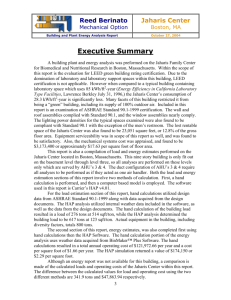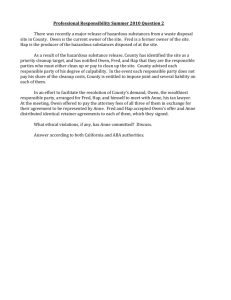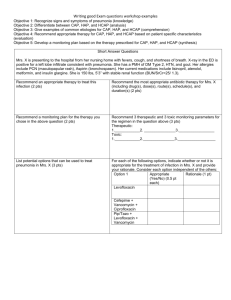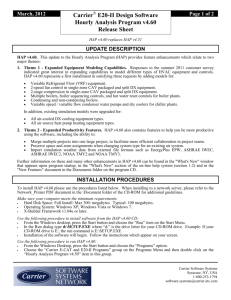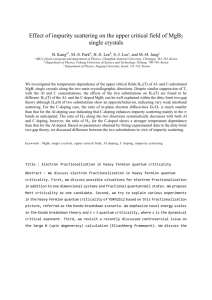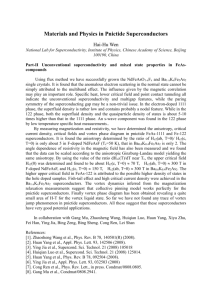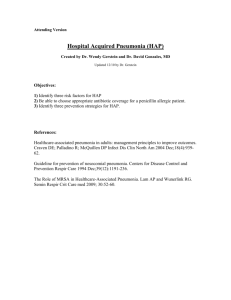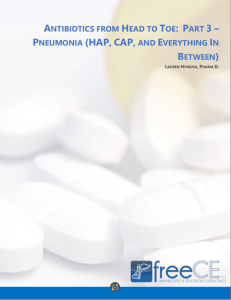Hospital Acquired Pneumonia in the Medical Intensive Care Unit
advertisement
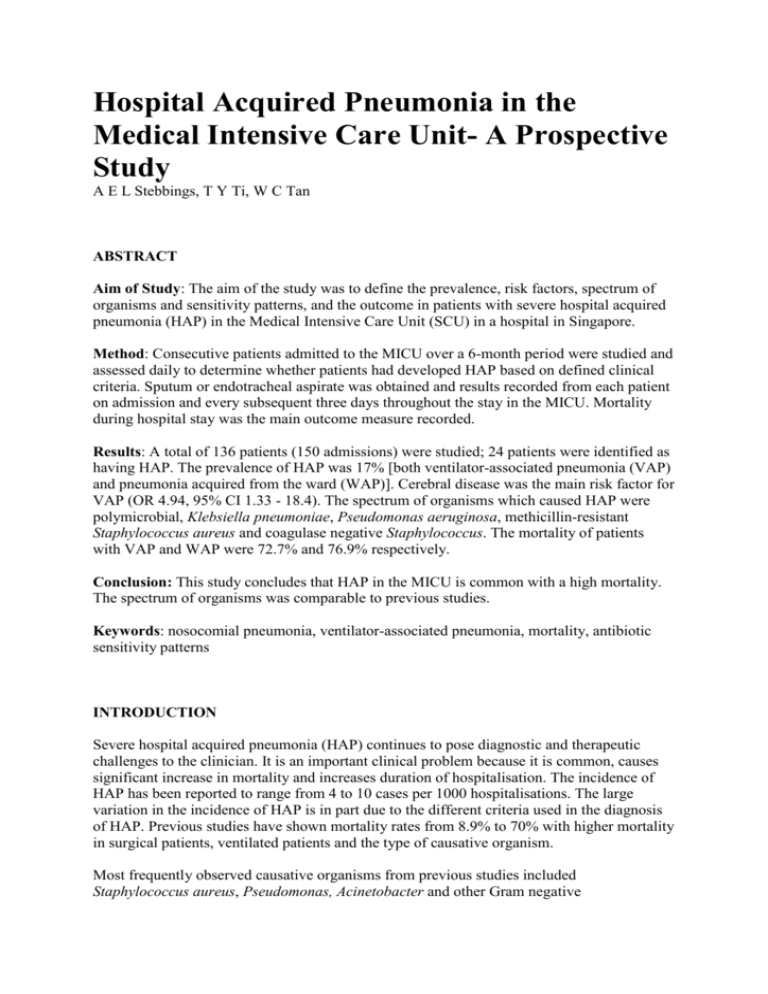
Hospital Acquired Pneumonia in the Medical Intensive Care Unit- A Prospective Study A E L Stebbings, T Y Ti, W C Tan ABSTRACT Aim of Study: The aim of the study was to define the prevalence, risk factors, spectrum of organisms and sensitivity patterns, and the outcome in patients with severe hospital acquired pneumonia (HAP) in the Medical Intensive Care Unit (SCU) in a hospital in Singapore. Method: Consecutive patients admitted to the MICU over a 6-month period were studied and assessed daily to determine whether patients had developed HAP based on defined clinical criteria. Sputum or endotracheal aspirate was obtained and results recorded from each patient on admission and every subsequent three days throughout the stay in the MICU. Mortality during hospital stay was the main outcome measure recorded. Results: A total of 136 patients (150 admissions) were studied; 24 patients were identified as having HAP. The prevalence of HAP was 17% [both ventilator-associated pneumonia (VAP) and pneumonia acquired from the ward (WAP)]. Cerebral disease was the main risk factor for VAP (OR 4.94, 95% CI 1.33 - 18.4). The spectrum of organisms which caused HAP were polymicrobial, Klebsiella pneumoniae, Pseudomonas aeruginosa, methicillin-resistant Staphylococcus aureus and coagulase negative Staphylococcus. The mortality of patients with VAP and WAP were 72.7% and 76.9% respectively. Conclusion: This study concludes that HAP in the MICU is common with a high mortality. The spectrum of organisms was comparable to previous studies. Keywords: nosocomial pneumonia, ventilator-associated pneumonia, mortality, antibiotic sensitivity patterns INTRODUCTION Severe hospital acquired pneumonia (HAP) continues to pose diagnostic and therapeutic challenges to the clinician. It is an important clinical problem because it is common, causes significant increase in mortality and increases duration of hospitalisation. The incidence of HAP has been reported to range from 4 to 10 cases per 1000 hospitalisations. The large variation in the incidence of HAP is in part due to the different criteria used in the diagnosis of HAP. Previous studies have shown mortality rates from 8.9% to 70% with higher mortality in surgical patients, ventilated patients and the type of causative organism. Most frequently observed causative organisms from previous studies included Staphylococcus aureus, Pseudomonas, Acinetobacter and other Gram negative organisms(4,7-9). A polymicrobial aetiology has been reported in 40% to 81% of cases depending on the setting and method of obtaining microbiological specimens. The aim of the study was to define the prevalence, risk factors, pattern of causative organisms and antibiotic sensitivities, and outcome of patients with HAP in the Medical Intensive Care Unit (MICU) in Singapore and to compare these results with previous studies. PATIENTS AND METHODS The study was conducted in the Medical Intensive Care Unit (MICU) of the National University Hospital, Singapore, over a 6-month period from June 1994 to December 1994. This is a 6-bedded MICU that serves patients from the Medical Department with over 7000 admissions each year. Consecutive patients admitted to the MICU were entered prospectively into the study and were assessed daily for HAP by a single independent investigator who was not involved in the treatment decisions of the patients. The following data were documented on admission to the MICU and upon diagnosis of HAP: (i) historical data of the admitting illness and co-morbid diseases; (ii) clinical findings; (iii) abnormalities on the chest radiograph; (iv) full blood count; (v) serum urea and electrolytes, and (vi) arterial blood gas results. In addition, details of instrumentation, duration of MICU stay, antibiotic treatment, results of sputum or endotracheal aspirate culture and sensitivity profile were recorded throughout each patient’s stay in the MICU. Voluntary expectoration of sputum or endotracheal aspirate was obtained from each patient at several time points: on admission to the MICU; every subsequent three days of MICU stay and as judged by the resident doctor. Gram stain, bacterial identification, culture and sensitivity were performed by standard methods. The criteria used for the diagnosis of HAP were: (i) a new persistent infiltrate on the chest radiograph 48 hours after admission to hospital not explained by other pathology such as pulmonary oedema and not deemed to be incubating at the time of admission into hospital, and (ii) one of the following: temperature of more than 38°C; leucocytosis of greater than 10 u 109/L; purulent sputum or endotracheal aspirate(1). The organism that caused the HAP was defined as the organism which was isolated from the sputum or endotracheal aspirate on the day of the diagnosis of HAP. Death was defined as pneumonia-related if the pneumonia was designated as the underlying or immediate cause of death or was determined to have a major contributing role in the cause of death. The primary outcome in the study was death, up to the time of discharge from hospital. In the event that a terminally ill patient was discharged at the patient’s request, information about the final outcome of the patient was obtained by telephone interview. Statistical analysis For the statistical analysis, all values were expressed as mean w standard deviation or as percentages. Characteristics of patients with and without HAP were compared using the c2 test, calculating the odds ratio (OR) for categorical variables. Comparisons of mortality between different groups identified were analysed using c2 calculating the relative risk (RR). A value of p l 0.05 was regarded as statistically significant. RESULTS A total of 136 patients (150 MICU admissions) were studied (65M, 71F, mean age 56.2 w 18.0 years). Ten patients were admitted more than once during the study period. Four main groups were identified as shown in Fig 1: (i) HAP while undergoing ventilatory support (VAP); HAP acquired from the general ward which subsequently required MICU care (ward associated pneumonia, WAP); (iii) severe community acquired pneumonia requiring MICU care (CAP), and (iv) patients who required intensive care monitoring for other reasons (Fig 1). Twenty four patients were identified with HAP: 11 patients with 12 episodes of VAP and 13 patients with 15 episodes of WAP. The prevalence of HAP in the MICU was 17%. In the 89 patients who were ventilated, the prevalence of VAP was 12%. The clinical characteristics and mortality of the patients with severe HAP are shown in Table I. The overall mortality rates for patients with HAP were high, as shown in Table I. These rates were significantly higher compared to patients without pneumonia: VAP (RR 1.72, 95% CI 1.13 - 2.60), WAP (RR 1.86, 95% CI 1.29 - 2.67). In eleven patients with VAP, nine died. However, in only one patient was death thought to be solely or predominantly due to VAP. In thirteen patients with WAP, ten patients died, but in only six patients was death caused by pneumonia. The details of the cause of death in the VAP and WAP groups are shown in Table IIA and IIB. The types of comorbid illness in the patients with HAP are shown in Table III. Cerebral disease was an increased risk for VAP (OR 4.94, 95% CI 1.33 - 1.84). The spectrum of cerebral disease in these patients included meningitis, meningoencephalitis, Parkinson’s disease, dementia and cerebral infarction. Underlying lung disease was not found to be a risk factor for HAP. However, underlying lung disease appeared to be associated with severe CAP (OR 3.65, 95% CI 1.20 - 11.2). Pathogens isolated in the VAP and WAP groups were similar (Table IV). In the VAP group, methicillin-resistant Staphylococcus aureus (MRSA), Pseudomonas aeruginosa and polymicrobial organisms were equally common and accounted for 75% of all organisms isolated. In the WAP group, the most common pathogen was Klebsiella pneumoniae, while Pseudomonas aeruginosa, MRSA and polymicrobial organisms were isolated with equal frequency. No organism was isolated from the blood in any patient. Pathogens from patients without pneumonia, by comparison, had predominantly no bacterial isolate. A marked difference was seen in the antibiotic sensitivity pattern for Klebsiella pneumoniae between the VAP and WAP group (Table V). Klebsiella pneumoniae isolated from the WAP group was sensitive to most standard antibiotics such as cephalexin, gentamicin and ceftriaxone but was resistant to ampicillin; whereas the Klebsiella pneumoniae strains isolated from the VAP group were multi-resistant. No clear pattern of antibiotic sensitivity for Pseudomonas aeruginosa could be defined in the VAP and WAP groups. Acinetobacter from both HAP groups was multi-resistant to cephalosporins, ciprofloxacin and imipenem but was sensitive to amikacin. The remaining gram negative organisms (Xanthomonas, Serratia and Citrobacter) had mixed sensitivity patterns but were generally sensitive to aminoglycosides. MRSA isolated in both VAP and WAP groups had similar antibiotic sensitivity patterns. This was sensitive to vancomycin, fusidic acid and clindamycin (with one exception resistant to clindamycin). Coagulase negative Staphylococcus organisms was sensitive to vancomycin only. DISCUSSION The main aim of this study was to prospectively define the clinical, bacteriological and antibiotic sensitivity profile of severe life-threatening HAP in the MICU. To our knowledge, there is only one other published report in the region comparing nosocomial pneumonia in normal and immunocompromised hosts with no documentation of organism antibiotic sensitivity patterns(13). This study emphasises the magnitude of severe life-threatening HAP and its high mortality. The common causative organisms implicated in HAP and their sensitivity patterns are documented and may provide guidance for the choice of empiric antibiotic treatment in seriously ill patients. The prevalence of HAP within the MICU was 17%. In ventilated patients, the prevalence of VAP was 12%. This compares favourably with previous studies with reported prevalences of VAP in ventilated patients ranging from 7% to 41%(2-5,14). The overall mortality rate was high compared to previous studies(1-3,7,10). Death caused by pneumonia was found to be different in the two groups, with mortality from VAP being much lower than previously reported. The reason for this is unclear. A possible explanation is the confounding factor of underlying illness in the patient as a cause of death. Therefore, the high mortality rates previously reported may be due to the difficulties in distinguishing between HAP and the underlying illness and complications in patients who died(6). The higher mortality in the WAP group versus the VAP group is likely due to greater extent of pneumonia in the WAP group, as suggested by more extensive radiological abnormalities (Table I). All patients who developed HAP in our study had comorbid multi-organ disease. Patients with cerebral disease had a significantly increased likelihood of developing VAP. This may be due to impaired gag and cough reflexes in these patients. The most common radiographic abnormality in the VAP group was lower lobe consolidation, suggesting aspiration as the aetiology of the pneumonia. This has been well described in other reports(2,5). The spectrum of organisms was comparable to other studies in the West(8,9,14,15). The antibiotic sensitivity patterns of the causative organisms in HAP appeared to be dependent on the setting within the hospital. Predominantly multi-organisms and multi-resistant strains were seen in the VAP group, whereas in the WAP group, the most common organism isolated was Klebsiella pneumoniae which was sensitive to commonly used antibiotics. This difference may reflect the intensive use of broad spectrum antibiotics in the MICU. Gram negative organisms were universally resistant to ampicillin, reflecting the widespread use of this common antibiotic in the community. Acinetobacter strains in particular, were multiresistant, which is comparable to previous reports(15,16). Bacterial identification in most patients with HAP who had positive cultures from endotracheal aspirates or sputum, whereas no organism was identified in the majority of patients with CAP, which is likely due to prior antibiotic treatment received before hospitalisation. The majority of patients with no pneumonia was unable to expectorate sputum spontaneously or with sputum induction, accounting for the small number of specimens obtained from this group. The limitations of our study were that: (i) the number of patients who had HAP was small; (ii) quantitative cultures of sputum and endotracheal aspirate specimens were not done, and (iii) the method of obtaining specimens was by voluntary expectoration of sputum or from the endotracheal aspirate(17,18). Nevertheless, this study gives some insight into the risk factors associated with developing HAP and the spectrum of organisms and their sensitivity profiles. The data suggests that the high mortality rates of patients who had died in the MICU could be due not only to the severity of the pneumonia but also due in part to the difficulty in differentiating between HAP and the underlying illness as the main cause of death. Further studies on severe HAP with larger number of patients and quantitative cultures of microbiological specimens are required to confirm the findings of this study.
